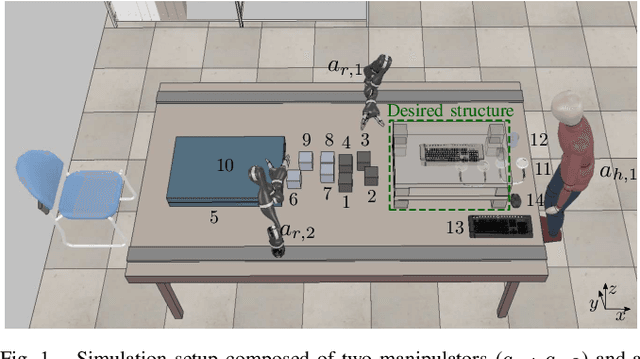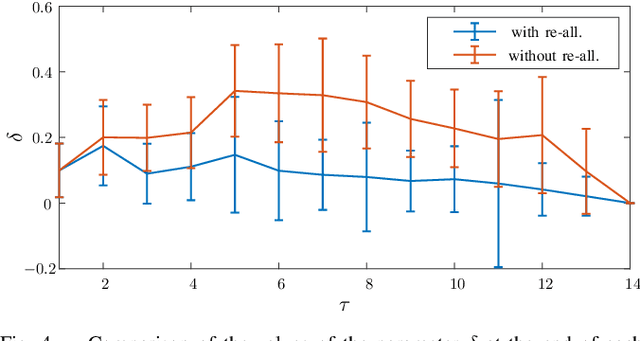Alessandro Marino
Visual Action Planning with Multiple Heterogeneous Agents
Mar 25, 2024Abstract:Visual planning methods are promising to handle complex settings where extracting the system state is challenging. However, none of the existing works tackles the case of multiple heterogeneous agents which are characterized by different capabilities and/or embodiment. In this work, we propose a method to realize visual action planning in multi-agent settings by exploiting a roadmap built in a low-dimensional structured latent space and used for planning. To enable multi-agent settings, we infer possible parallel actions from a dataset composed of tuples associated with individual actions. Next, we evaluate feasibility and cost of them based on the capabilities of the multi-agent system and endow the roadmap with this information, building a capability latent space roadmap (C-LSR). Additionally, a capability suggestion strategy is designed to inform the human operator about possible missing capabilities when no paths are found. The approach is validated in a simulated burger cooking task and a real-world box packing task.
A Task Allocation Framework for Human Multi-Robot Collaborative Settings
Oct 25, 2022Abstract:The requirements of modern production systems together with more advanced robotic technologies have fostered the integration of teams comprising humans and autonomous robots. However, along with the potential benefits also comes the question of how to effectively handle these teams considering the different characteristics of the involved agents. For this reason, this paper presents a framework for task allocation in a human multi-robot collaborative scenario. The proposed solution combines an optimal offline allocation with an online reallocation strategy which accounts for inaccuracies of the offline plan and/or unforeseen events, human subjective preferences and cost of switching from one task to another so as to increase human satisfaction and team efficiency. Experiments are presented for the case of two manipulators cooperating with a human operator for performing a box filling task.
Augment-Connect-Explore: a Paradigm for Visual Action Planning with Data Scarcity
Mar 24, 2022



Abstract:Visual action planning particularly excels in applications where the state of the system cannot be computed explicitly, such as manipulation of deformable objects, as it enables planning directly from raw images. Even though the field has been significantly accelerated by deep learning techniques, a crucial requirement for their success is the availability of a large amount of data. In this work, we propose the Augment-Connect-Explore (ACE) paradigm to enable visual action planning in cases of data scarcity. We build upon the Latent Space Roadmap (LSR) framework which performs planning with a graph built in a low dimensional latent space. In particular, ACE is used to i) Augment the available training dataset by autonomously creating new pairs of datapoints, ii) create new unobserved Connections among representations of states in the latent graph, and iii) Explore new regions of the latent space in a targeted manner. We validate the proposed approach on both simulated box stacking and real-world folding task showing the applicability for rigid and deformable object manipulation tasks, respectively.
Safety in human-multi robot collaborative scenarios: a trajectory scaling approach
Jul 16, 2021



Abstract:In this paper, a strategy to handle the human safety in a multi-robot scenario is devised. In the presented framework, it is foreseen that robots are in charge of performing any cooperative manipulation task which is parameterized by a proper task function. The devised architecture answers to the increasing demand of strict cooperation between humans and robots, since it equips a general multi-robot cell with the feature of making robots and human working together. The human safety is properly handled by defining a safety index which depends both on the relative position and velocity of the human operator and robots. Then, the multi-robot task trajectory is properly scaled in order to ensure that the human safety never falls below a given threshold which can be set in worst conditions according to a minimum allowed distance. Simulations results are presented in order to prove the effectiveness of the approach.
* Link to the paper: https://www.sciencedirect.com/science/article/pii/S2405896318332464
A Data-Driven Approach for Contact Detection, Classification and Reaction in Physical Human-Robot Collaboration
Jun 12, 2021



Abstract:This paper considers a scenario where a robot and a human operator share the same workspace, and the robot is able to both carry out autonomous tasks and physically interact with the human in order to achieve common goals. In this context, both intentional and accidental contacts between human and robot might occur due to the complexity of tasks and environment, to the uncertainty of human behavior, and to the typical lack of awareness of each other actions. Here, a two stage strategy based on Recurrent Neural Networks (RNNs) is designed to detect intentional and accidental contacts: the occurrence of a contact with the human is detected at the first stage, while the classification between intentional and accidental is performed at the second stage. An admittance control strategy or an evasive action is then performed by the robot, respectively. The approach also works in the case the robot simultaneously interacts with the human and the environment, where the interaction wrench of the latter is modeled via Gaussian Mixture Models (GMMs). Control Barrier Functions (CBFs) are included, at the control level, to guarantee the satisfaction of robot and task constraints while performing the proper interaction strategy. The approach has been validated on a real setup composed of a Kinova Jaco2 robot.
A Mixed-Integer Linear Programming Formulation for Human Multi-Robot Task Allocation
Jun 12, 2021



Abstract:In this work, we address a task allocation problem for human multi-robot settings. Given a set of tasks to perform, we formulate a general Mixed-Integer Linear Programming (MILP) problem aiming at minimizing the overall execution time while optimizing the quality of the executed tasks as well as human and robotic workload. Different skills of the agents, both human and robotic, are taken into account and human operators are enabled to either directly execute tasks or play supervisory roles; moreover, multiple manipulators can tightly collaborate if required to carry out a task. Finally, as realistic in human contexts, human parameters are assumed to vary over time, e.g., due to increasing human level of fatigue. Therefore, online monitoring is required and re-allocation is performed if needed. Simulations in a realistic scenario with two manipulators and a human operator performing an assembly task validate the effectiveness of the approach.
Enabling Visual Action Planning for Object Manipulation through Latent Space Roadmap
Mar 03, 2021



Abstract:We present a framework for visual action planning of complex manipulation tasks with high-dimensional state spaces, focusing on manipulation of deformable objects. We propose a Latent Space Roadmap (LSR) for task planning, a graph-based structure capturing globally the system dynamics in a low-dimensional latent space. Our framework consists of three parts: (1) a Mapping Module (MM) that maps observations, given in the form of images, into a structured latent space extracting the respective states, that generates observations from the latent states, (2) the LSR which builds and connects clusters containing similar states in order to find the latent plans between start and goal states extracted by MM, and (3) the Action Proposal Module that complements the latent plan found by the LSR with the corresponding actions. We present a thorough investigation of our framework on two simulated box stacking tasks and a folding task executed on a real robot.
Latent Space Roadmap for Visual Action Planning of Deformable and Rigid Object Manipulation
Mar 19, 2020



Abstract:We present a framework for visual action planning of complex manipulation tasks with high-dimensional state spaces such as manipulation of deformable objects. Planning is performed in a low-dimensional latent state space that embeds images. We define and implement a Latent Space Roadmap (LSR) which is a graph-based structure that globally captures the latent system dynamics. Our framework consists of two main components: a Visual Foresight Module (VFM) that generates a visual plan as a sequence of images, and an Action Proposal Network (APN) that predicts the actions between them. We show the effectiveness of the method on a simulated box stacking task as well as a T-shirt folding task performed with a real robot.
 Add to Chrome
Add to Chrome Add to Firefox
Add to Firefox Add to Edge
Add to Edge